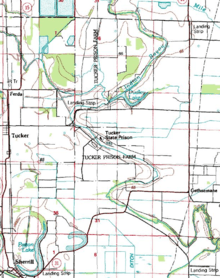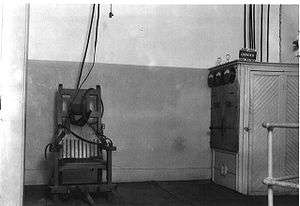Tucker Unit

Coordinates: 34°27′16″N 91°54′56″W / 34.454539°N 91.915571°W The Tucker Unit is a prison in Tucker, Dudley Lake Township, unincorporated Jefferson County, Arkansas, 25 miles (40 km) northeast of Pine Bluff. It is operated by the Arkansas Department of Correction (ADC).[1] Tucker is one of the state of Arkansas's "parent units" for male prisoners; it serves as one of several units of initial assignment for processed male prisoners.[2]
A Maximum Security Unit was constructed a short distance north of the Tucker Unit in 1983.
History

In 1916 the State of Arkansas purchased about 4,400 acres (1,800 ha) of land to build the Tucker Unit. In 1933 Governor of Arkansas Junius Marion Futrell closed the Arkansas State Penitentiary ("The Walls"), and some prisoners moved to Tucker from the former penitentiary. In the process the designated execution chamber moved to Tucker.[3] "Old Sparky", in operation within the state system from 1926 to 1948, was the equipment used to kill condemned prisoners at Tucker.[4] In 1964 Charles Fields was executed at Tucker; he was the last prisoner to be executed at Tucker before the Arkansas death penalty was declared against the U.S. constitution.[3] In history, the prison housed the state's White convicts.[5] In addition the prison housed some black female prisoners.[3]
In 1967 four men escaped from the unit and abandoned a vehicle used in the escape in Fort Scott, Kansas.[6]
The Arkansas prison scandal occurred in the unit and involved the "Tucker Telephone."[7] Due to the notoriety of the device, as of 2000 visitors to the Tucker Unit on a regular basis ask the warden if the telephone on his/her desk is the "Tucker Telephone."[8]
In 1974 death row inmates, previously at the Tucker Unit, were moved to the Cummins Unit.[9] In 1978 a new death chamber opened in Cummins, so Tucker was no longer the place of execution in Arkansas.[3]
In 2000 the ADC's final 100 person barracks was split into two smaller barracks.[3]
In 2009 prison guards left a prisoner in his own feces for a weekend. The prisoner had to be hospitalized. The Associated Press discovered that prison guards had received lap dances while working. The prison system fired several correctional employees. The same year, a Heber Springs, Arkansas man who was wanted for not reporting to his parole officer appeared at the Tucker Unit. A prison guard shot him dead. Dina Tyler, a spokesperson for the prison system, said that the man crashed his car into the car owned by the assistant warden and was "very close to the officers" prior to his death.[10]
Composition and operations

Of the land at the Tucker Unit, 4,500 acres (1,800 ha) are used to farm rice and soybeans.[11]
The unit houses a campus of the Riverside Vocational Technical School.[12] Education in the Tucker Unit began in 1968, when the England School District started a night program.[13]
In historical eras, white prisoners worked in the fields, and the prison housed clothing, license plate, and shoe factories.[5]
As of 2009, 532 prisoners live in the Maximum Security Unit. That year, of the prisoners, 100 live in a barrack-style dormitory and have jobs in the prison.[10]
Notable prisoners
Maximum Security Unit death row:
References
- ↑ "Tucker Unit." Arkansas Department of Correction. Retrieved on July 11, 2010.
- ↑ "Guide for Family and Friends." Arkansas Department of Correction. 2 (4/27). Retrieved on July 18, 2010.
- 1 2 3 4 5 "Prison History and Gallery." Arkansas Department of Correction. Retrieved on September 7, 2010.
- ↑ "Gallery." Arkansas Department of Correction. Retrieved on August 15, 2010.
- 1 2 Federal Writers' Project. Arkansas: A Guide to the State. US History Publishers, 1958. 346. Retrieved from Google Books on March 6, 2011. ISBN 1-60354-004-0, ISBN 978-1-60354-004-9
- ↑ "Link Truck Here in Prison Flight." The Fort Scott Tribune. Tuesday January 17, 1967. Retrieved from Google News (1 of 4) on March 6, 2011.
- ↑ Champion, Dean J. Dictionary of American Criminal Justice: Key Terms and Major Supreme Court Cases. Taylor & Francis, 1998. 9. Retrieved from Google Books on August 18, 2010. ISBN 1-57958-073-4, ISBN 978-1-57958-073-5.
- ↑ Feeley, Malcolm M. and Edward L. Rubin. Judicial Policy Making and the Modern State: How the Courts Reformed America's Prisons. Cambridge University Press, 2000. 58. Retrieved from Google Books on March 5, 2011. ISBN 0-521-77734-8, ISBN 978-0-521-77734-6
- ↑ "2006 Facts Brochure." Arkansas Department of Correction. July 1, 2005-June 30, 2006. 25 (25/38). Retrieved on August 15, 2010.
- 1 2 "Arkansas Inmate Nearly Dies After Left in Feces." (Archive) Associated Press at Fox News. June 22, 2009. Retrieved on April 15, 2013.
- ↑ "2006 Fact Brochure." Arkansas Department of Correction. 8 (8/38). Retrieved on March 8, 2011.
- ↑ "Campuses." Riverside Vocational Technical School. Retrieved on March 6, 2011.
- ↑ "History And Description Of The Arkansas Correctional School." Arkansas Correctional School. Retrieved on March 7, 2011.
- ↑ "Murderer Moved to Death Watch Cell" (Archive). Associated Press at The Oklahoman. April 16, 1995. Retrieved on March 13, 2015.
External links
- "Tucker Unit." Arkansas Department of Corrections.
- Shaw, Robert L. "Inmates of Arkansas Prison Disclose Stories of Torture, Beatings, Extortion." Associated Press at Nashua Telegraph. Wednesday January 18, 1967. Second Section p. 21. Retrieved from Google News (21/36).
| ||||||||||||||